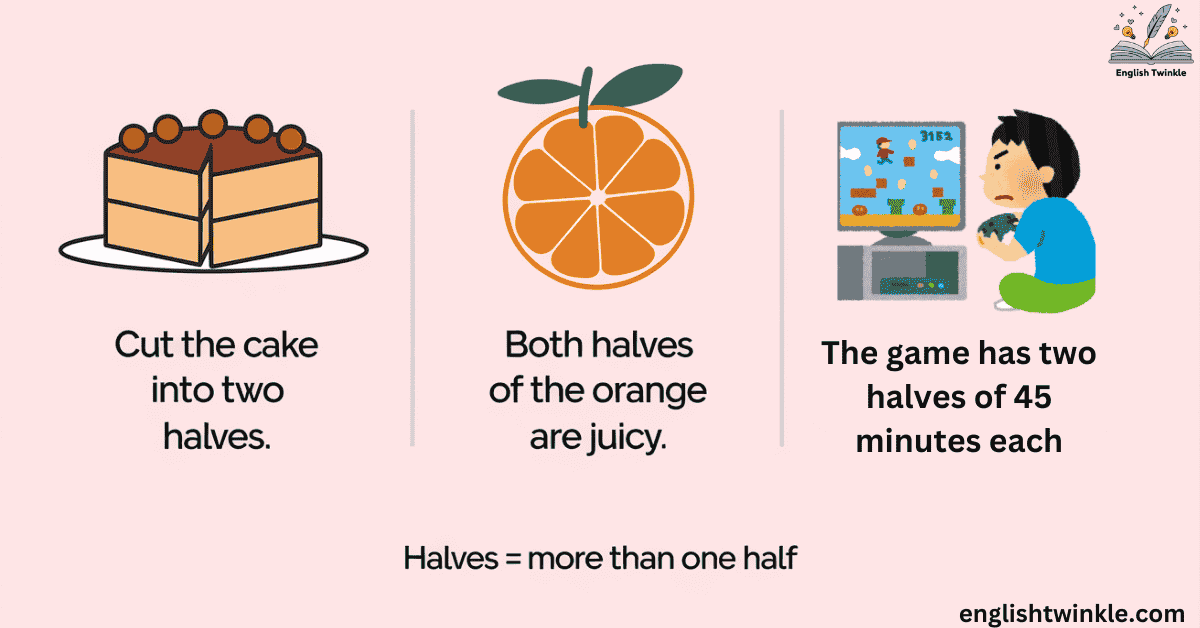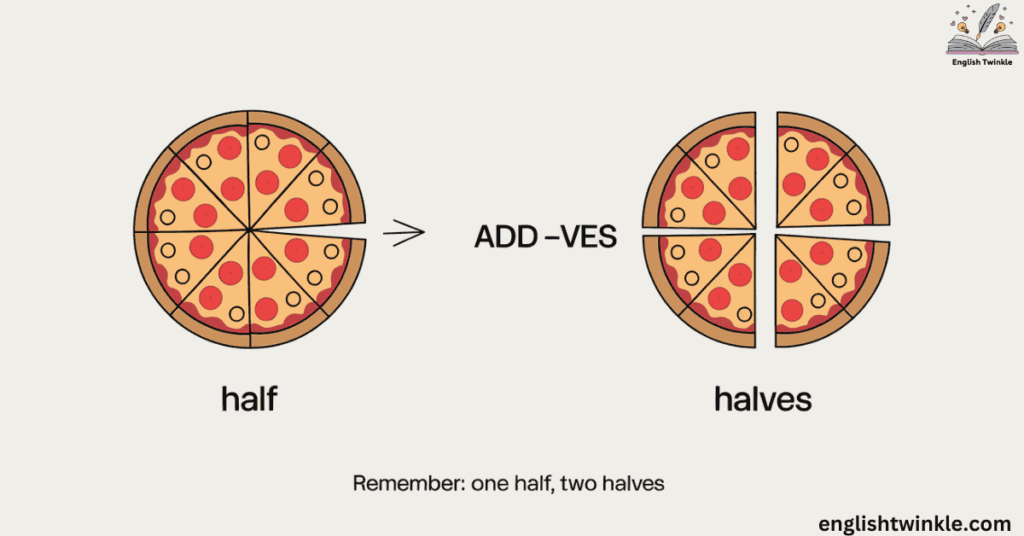English grammar is often full of surprises, especially when it comes to plurals. One of the most common questions people ask is: What’s the plural of half? Unlike regular nouns that simply add -s or -es to form plurals, half follows an irregular pattern. This article will dive deep into the singular and plural forms of “half,” explore other nouns ending in -f/-fe, and provide clear examples of noun usage to help you understand these grammar rules better.
We’ll also examine the etymology and meaning of the word “half,” provide synonyms, and offer a short quiz at the end to test your knowledge. So, whether you’re a language enthusiast or just curious about English nouns, this article will help you navigate the grammatical nuances of singular and plural nouns like “half.”
Introduction: The Curious Case of the Plural of Half
In English, most plural nouns are formed by simply adding -s or -es to their singular forms, such as cat/cats or box/boxes. However, some nouns like “half” don’t follow this straightforward rule. Instead, they belong to a special category of words that change their endings when pluralized.
The plural of half is halves, where the f changes to ve before the -s is added. This is part of a broader pattern seen in other nouns ending in -f or -fe, like knife/knives and leaf/leaves. While this rule might seem arbitrary, it has historical roots in the evolution of the English language.
Singular Form of Half
Meaning of “Half”
At its core, half refers to one of two equal parts of a whole. It’s a noun that describes a division, whether that’s of a physical object, time, or even abstract concepts like responsibility. In its singular form, half occupies an important place in our daily communication.
Examples of “half” in sentences:
- “I drank half of the water before the break.”
- “She spent half her savings on the trip.”
- “Half the class was absent due to illness.”
In each sentence, half is representing a singular noun, meaning one part of something divided into two equal portions.
Word Meaning Table: “Half” and Related Terms
| Word | Meaning | Example Usage |
|---|---|---|
| Half | One of two equal parts | “I ate half of the pizza.” |
| Part | A piece or segment of something larger | “A part of the puzzle is missing.” |
| Portion | A section or allotment of something | “He served a portion of the dessert.” |
| Fraction | A small or exact part of a whole | “Only a fraction of the audience applauded.” |
| Segment | A division or section of a whole | “They bought a segment of the company’s shares.” |
Usage of “Half” in Everyday Contexts
In everyday language, half can apply to almost anything that’s divisible. You can have half a sandwich, spend half an hour on a task, or even take half a day off work. The word is often used to describe equal portions, but it can also be used metaphorically.
For example:
- “She gave a half-hearted attempt at finishing her homework.”
- “He made a half-baked plan to fix the issue.”
In these cases, half is used as an adjective to describe something incomplete or not fully realized.
Plural Form: Halves
Why is the Plural of “Half” Halves?
The plural of half is halves, and it’s an example of an irregular plural form. Rather than just adding -s or -es, the f in “half” changes to ve before the plural -s is added. This change is part of a larger pattern in English, where certain nouns ending in -f or -fe undergo a transformation when pluralized.
Examples of “halves” in sentences:
- “Both halves of the orange were perfectly juicy.”
- “We split the project into two halves to manage it better.”
- “The two halves of the team worked together to win the game.”
Word Meaning Table: “Half” vs. “Halves”
| Singular Noun | Plural Noun | Meaning |
|---|---|---|
| Half | Halves | One of two equal parts (singular), two equal parts (plural) |
| Knife | Knives | A cutting tool (singular), multiple cutting tools (plural) |
| Leaf | Leaves | A flat structure on a plant (singular), multiple leaves (plural) |
| Wolf | Wolves | A wild carnivorous animal (singular), multiple wolves (plural) |
| Calf | Calves | A young cow or bull (singular), multiple young cows (plural) |
The Rule for Nouns Ending in -f or -fe
In English, certain nouns that end in -f or -fe change to -ves in the plural form. This rule has exceptions and is often confusing for learners. However, understanding the rule will help you with similar words like half/halves.
- Singular: half, knife, leaf, wolf, calf
- Plural: halves, knives, leaves, wolves, calves
Not all words that end in -f or -fe follow this rule. For instance, the plural of “roof” is “roofs,” not “rooves.” Similarly, “chief” becomes “chiefs” rather than “chieves.” These exceptions often depend on the word’s history and its phonetic properties.
Irregular Plural Nouns Ending in -f/-fe
The plural of half follows a pattern that applies to several other nouns ending in -f or -fe. These words don’t pluralize by simply adding -s or -es, but instead, the f changes to ves.
Common Examples of Irregular Plural Nouns
| Singular Noun | Plural Noun | Meaning |
|---|---|---|
| Half | Halves | One of two equal parts (singular), two equal parts (plural) |
| Knife | Knives | A cutting tool (singular), multiple cutting tools (plural) |
| Leaf | Leaves | A flat structure on a plant (singular), multiple leaves (plural) |
| Wolf | Wolves | A wild carnivorous animal (singular), multiple wolves (plural) |
| Calf | Calves | A young cow or bull (singular), multiple young cows (plural) |
| Wife | Wives | A married woman (singular), married women (plural) |
| Thief | Thieves | Someone who steals (singular), multiple thieves (plural) |
| Life | Lives | The existence of an individual (singular), multiple existences (plural) |
| Shelf | Shelves | A flat surface for storage (singular), multiple surfaces (plural) |
| Elf | Elves | A mythical or magical creature (singular), multiple elves (plural) |
These irregular plural forms can be tricky to remember, but they follow a predictable pattern, with some exceptions. Knowing these patterns will help you navigate the complexities of English grammar more confidently.
Contextual Examples of “Half” in Sentences
Understanding how to use half and halves correctly in sentences is crucial for mastering noun usage. Here are some examples of half in its singular form:
- “She only ate half of the chocolate bar.”
- “He spent half his day working on the project.”
- “Half of the students didn’t complete their assignments.”
In these examples, half represents a singular noun, referring to one division of a whole.
Contextual Examples of “Halves” in Sentences

When we use halves, we’re referring to multiple divisions of a whole. Here are some sentences that demonstrate the correct usage of halves:
- “The two halves of the cake were decorated differently.”
- “We divided the work into two equal halves.”
- “Both halves of the couple’s estate were sold after the divorce.”
Using halves correctly in sentences is key to understanding irregular plurals and their role in noun rules.
Synonyms and Related Words for “Half”
Sometimes, you may want to use a synonym instead of “half” to avoid repetition in your writing. Here are some synonyms and related words that can be used in place of half:
| Word | Meaning | Example Usage |
|---|---|---|
| Part | A portion or division of something | “They each received part of the inheritance.” |
| Portion | A section or share of a whole | “He took a large portion of the cake.” |
| Fraction | A small or broken part of something | “Only a fraction of the population voted.” |
| Division | The action of separating something into parts | “The division of labor made the task easier.” |
| Segment | A part of something larger | “A segment of the market prefers organic products.” |
These words can help you vary your language while still conveying the same meaning as half or halves.
Origin and Etymology of the Word “Half”
The word half has deep roots in the history of the English language. It comes from the Old English word healf, which means “side” or “part.” This word is also related to the Old Norse word halfr, which carries a similar meaning.
The plural form, halves, evolved in line with other nouns ending in -f or -fe that follow the f-to-ves rule. This change occurred over centuries as the English language developed and became more standardized.
Why Is This Important?
Understanding the etymology of words like “half” can shed light on why they behave the way they do in terms of grammar. The irregular plural forms of words like half/halves are relics of older linguistic patterns that have persisted into modern English.
Common Mistakes and Misunderstandings with “Half”
One of the most common mistakes people make with the word “half” is forming the plural incorrectly. Some learners of English might assume that half follows regular pluralization rules and incorrectly write halfs instead of halves.
Incorrect Example:
- “We divided the cake into two halfs.” ❌
Correct Example:
- “We divided the cake into two halves.” ✔️
To avoid this error, always remember that half is part of a group of irregular plural nouns that change f to ves in the plural form.
Quiz: Test Your Knowledge on Singular and Plural Nouns
Now that you’ve learned about the plural of half and other irregular plurals, it’s time to test your knowledge! Try out this short quiz to see how well you’ve understood the concepts.
Questions:
- What is the plural of “half”?
- a) Halfs
- b) Halves
- c) Halfes
- Which of the following is an example of a noun ending in -f or -fe that changes to ves in the plural form?
- a) Roof
- b) Chief
- c) Knife
- Which of these sentences is correct?
- a) “He cut the apple into two halfs.”
- b) “He cut the apple into two halves.”
- What is the singular form of “leaves”?
- a) Leaf
- b) Leafe
- c) Leaves
- Which of these words is a synonym for “half”?
- a) Segment
- b) Whole
- c) Entirety
Answers:
- b) Halves
- c) Knife
- b) “He cut the apple into two halves.”
- a) Leaf
- a) Segment
Conclusion: Mastering Singular and Plural Nouns Like “Half”
By now, you should have a solid grasp of how to use half and halves correctly. You’ve learned about other irregular plural nouns and how they follow the f-to-ves rule. Understanding these grammar rules is essential for mastering English nouns and communicating more effectively.
In summary, the division of nouns into singular and plural forms can sometimes be tricky, but with practice, you’ll be able to apply these grammar rules with ease. Whether you’re writing, speaking, or simply curious about language, knowing the correct forms of words like half and halves will improve your overall understanding of English grammar.
Sources and Further Reading
These resources provide further insights into noun forms, grammar terms, and the division of nouns in English.

